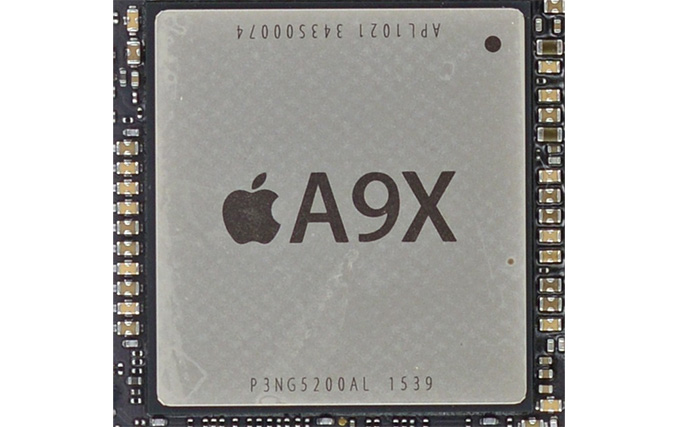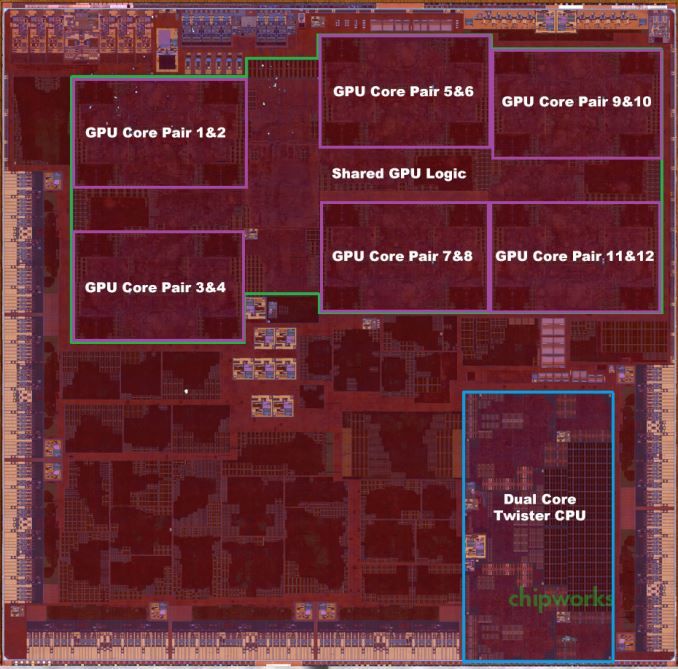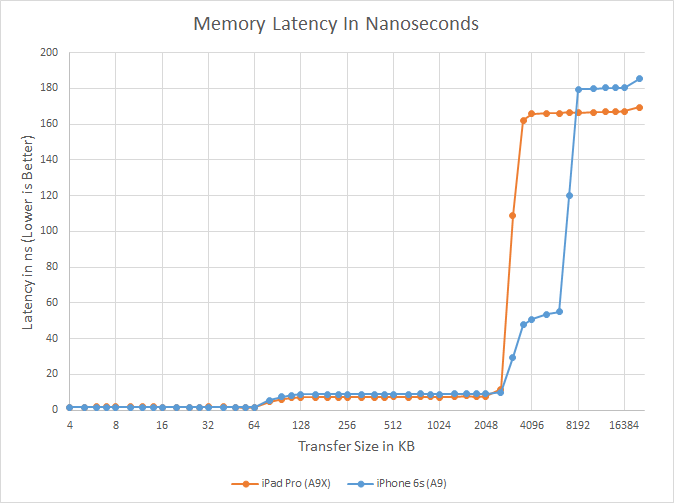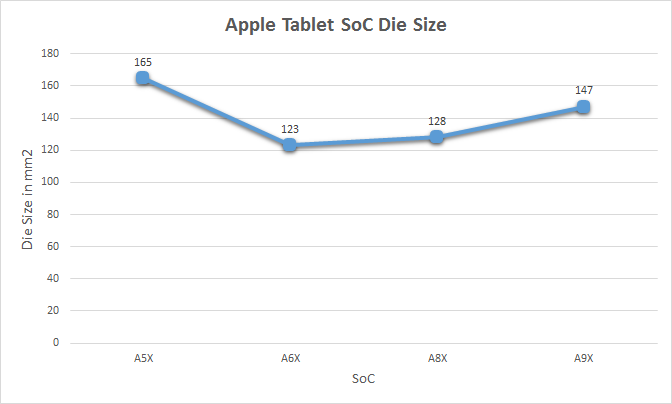The Apple iPad Pro Review
by Ryan Smith, Joshua Ho & Brandon Chester on January 22, 2016 8:10 AM ESTSoC Analysis: Apple A9X
Diving into the heart of the iPad Pro, we have Apple’s latest generation tablet SoC, A9X. Like the other Apple X series SoCs before it, A9X is by and large an enhanced and physically larger version of Apple’s latest phone SoC, taking advantage of the greater space and heat dissipation afforded by a tablet to produce a more powerful SoC.

Apple's A9X (Image Courtesy iFixit)
That Apple has developed a new SoC to launch alongside the iPad Pro is in no way surprising, but just as how the iPad Pro has ramifications for the overall iPad lineup as Apple gets into the productivity tablet market, iPad Pro’s genesis is reflected in its component selection. Apple already needed a powerful SoC for the iPad Air 2 in order to keep performance up with the tablet’s high resolution of the screen, and iPad Pro in turn pushes Apple’s performance needs even harder. Not only is there an even higher resolution screen to drive – the 2732x2048 display has about 66% of the pixels of a 4K display – but now Apple needs to deliver suitable performance for content creation and meaningful multitasking. I don’t want to imply that the A9X was somehow specifically designed from scratch for the iPad Pro, as there are a number of more important engineering considerations, but I do want to highlight how the iPad Pro is not just another iPad, and that as Apple expands the capabilities of the iPad they need to expand the performance as well if they wish to extend their reputation for smooth UX performance.
Looking at the specifications of the A9X, it seems like Apple always throws us a curveball on the X series SoCs, and for their latest SoC this is no different. With A8X Apple delivered more RAM on a wider memory bus, a larger GPU, and surprisingly, three Typhoon CPU cores. To date it’s still not clear just why Apple went with three CPU cores on A8X – was it for multitasking, or as an alternative means to boost performance – and A9X’s configuration only serves to highlight this enigma.
| Apple SoC Comparison | ||||||
| A9X | A9 | A8X | A6X | |||
| CPU | 2x Twister | 2x Twister | 3x Typhoon | 2x Swift | ||
| CPU Clockspeed | 2.26GHz | 1.85GHz | 1.5GHz | 1.3GHz | ||
| GPU | PVR 12 Cluster Series7XT | PVR 6 Cluster Series7 (PVR GT7600) |
PVR 8 Cluster Series6XT (APL GXA6850) |
PVR SGX554 MP4 | ||
| RAM | 4GB LPDDR4 | 2GB LPDDR4 | 2GB LPDDR3 | 1GB LPDDR2 | ||
| Memory Bus Width | 128-bit | 64-bit | 128-bit | 128-bit | ||
| Memory Bandwidth | 51.2GB/sec | 25.6GB/sec | 25.6GB/sec | 17.1GB/sec | ||
| L2 Cache | 3MB | 3MB | 2MB | 1MB | ||
| L3 Cache | None | 4MB | 4MB | N/A | ||
| Manufacturing Process | TSMC 16nm FinFET | TSMC 16nm & Samsung 14nm |
TSMC 20nm | Samsung 32nm | ||
Instead of continuing with a triple-core CPU design for A9X, for their latest X series SoC Apple has dropped back down to just a pair of Twister CPU cores. The catch here – and why two cores is in many ways better than three – is that relative to A8X and A9, Apple has cranked up their CPU clockspeeds. Way, way up. Whereas the iPad Air 2 (A8X) shipped at 1.5GHz and the iPhone 6s (A9) at 1.85GHz, the A9X sees Apple push their clockspeed to 2.26GHz. Not counting the architectural changes, this is 22% higher clocked than the A9 and 51% higher than the A8X.
The fact that Apple dropped back down to 2 CPU cores is unexpected given that we don’t expect Apple to ever go backwards in such a fashion, and while we’ll never know the official reason for everything Apple does, in retrospect I’m starting to think that A8X was an anomaly and Apple didn’t really want a tri-core CPU in the first place. A8X came at a time where Apple was bound by TSMC’s 20nm process and couldn’t drive up their clockspeeds without vastly increasing power consumption, so a third core was a far more power effective option.

A9X Die Shot w/AT Annotations (Die Shot Courtesy Chipworks)
Overall this means that iPad Pro and A9X will set a very high bar for tablet CPU performance. As we’ve already seen in the iPhone 6s review, the Twister CPU core is very potent and in most cases faster than any other ARM CPU core by leaps and bounds. Cranking up the clockspeed a further 22% only serves to open up that gap even further, as Twister is now reaching clockspeeds similar to the likes of Cortex-A57 and A72, but with its much wider execution pipeline and greater IPC. This is also the reason that an Intel Core CPU comparison is so interesting, as Intel’s tablet-class Core processors in many ways are the target to beat on overall CPU performance, and we’ll be touching upon this subject in greater detail a bit later.
GPU: Imagination PowerVR 12 Cluster Series 7XT
Meanwhile on the GPU side, as expected Apple has further increased the number of clusters on their SoC to drive the higher resolution display of a tablet. Whereas A9 used a 6 cluster design (PVR GT7600), A9X doubles this, giving us a relatively massive 12 cluster design.
In Imagination’s PowerVR Series7XT roadmap, the company doesn’t have an official name for a 12 cluster configuration, as this falls between the 8 cluster GT7800 and 16 cluster GT7900. So for the moment I’m simply calling it a “PowerVR 12 cluster Series7XT design,” and with any luck Imagination will use a more fine-grained naming scheme for future generations of PowerVR graphics.
In any case, the use of a 12 cluster design is a bit surprising from an engineering standpoint since it means that Apple was willing to take the die space hit to implement additional GPU clusters, despite the impact this would have on chip yields and costs. If anything, with the larger thermal capacity and battery of the iPad Pro, I had expected Apple to use higher GPU clockspeeds (and eat the power cost) in order to save on chip costs. Instead what we’re seeing is a GPU that essentially offers twice the GPU power of A9’s GPU.
However to put all of this in context, keep in mind that iPad Pro’s display is 5.95Mpixels, versus the 2.07Mpixel screen on the iPhone 6s Plus. So although Apple has doubled the number of GPU clusters for A9X – and I suspect clocked it fairly similarly – that increased performance will be very quickly consumed by the iPad Pro’s high resolution screen. Consequently even a 12 cluster GPU design is something of a compromise; if Apple wanted to maintain the same level of GPU performance per pixel as in the iPhone 6s family, they would have needed an even more powerful GPU. Which just goes to show how demanding tablets can be.
Memory Subsystem: 128-bit LPDDR4-3200, No L3 Cache
Responsibility for feeding the beast that is A9X’s GPU falls to A9X’s 128-bit LPDDR4 memory controller configuration. With twice as many GPU clusters, Apple needs twice as much memory bandwidth to maintain the same bandwidth-to-core ratio, so like the past X-series tablet SoCs, A9X implements a 128-bit bus. For Apple this means they now have a sizable 51.2GB/sec of memory bandwidth to play with. For an SoC this is a huge amount of bandwidth, but at the same time it’s quickly going to be consumed by those 12 GPU clusters.
| Geekbench 3 Memory Bandwidth Comparison (1 thread) | ||||||
| Stream Copy | Stream Scale | Stream Add | Stream Triad | |||
| Apple A9X 2.26GHz | 20.8 GB/s | 15.0 GB/s | 15.3 GB/s | 15.1 GB/s | ||
| Apple A8X 1.5GHz | 14.2 GB/s | 7.44 GB/s | 7.54 GB/s | 7.49 GB/s | ||
| A9X Advantage | 46.4% | 101% | 103% | 102% | ||
It’s also while looking at A9X’s memory subsystem however that we find our second and final curveball for A9X: the L3 cache. Or rather, the lack thereof. For multiple generations now Apple has used an L3 cache on both their phone and tablet SoCs to help feed both the CPU and GPU, as even a fast memory bus can’t keep up with a low latency local cache. Even as recent as A9, Apple included a 4MB victim cache. However for A9X there is no L3 cache; the only caches on the chip are the individual L1 and L2 caches for the CPU and GPU, along with some even smaller amounts for cache for various other functional blocks..
The big question right now is why Apple would do this. Our traditional wisdom here is that the L3 cache was put in place to service both the CPU and GPU, but especially the GPU. Graphics rendering is a memory bandwidth-intensive operation, and as Apple has consistently been well ahead of many of the other ARM SoC designers in GPU performance, they have been running headlong into the performance limitations imposed by narrow mobile memory interfaces. An L3 cache, in turn, would alleviate some of that memory pressure and keep both CPU and GPU performance up.
One explanation may be that Apple deemed the L3 cache no longer necessary with the A9X’s 128-bit LPDDR4 memory bus; that 51.2GB/sec of bandwidth meant that they no longer needed the cache to avoid GPU stalls. However while the use of LPDDR4 may be a factor, Apple’s ratio of bandwidth-to-GPU cores of roughly 4.26GB/sec-to-1 core is identical to A9’s, which does have an L3 cache. With A9X being a larger A9 in so many ways, this alone isn’t the whole story.
What’s especially curious is that the L3 cache on the A9 wasn’t costing Apple much in the way of space. Chipworks puts the size of A9’s 4MB L3 cache block at a puny ~4.5 mm2, which is just 3% the size of A9X. So although there is a cost to adding L3 cache, unless there are issues we can’t see even with a die shot (e.g. routing), Apple didn’t save much by getting rid of the L3 cache.
Our own Andrei Frumusanu suspects that it may be a power matter, and that Apple was using the L3 cache to save on power-expensive memory operations on the A9. With A9X however, it’s a tablet SoC that doesn’t face the same power restrictions, and as a result doesn’t need a power-saving cache. This would be coupled with the fact that with double the GPU cores, there would be a lot more pressure on just a 4MB cache versus the pressure created by A9, which in turn may drive the need for a larger cache and ultimately an even larger die size.
As it stands there’s no one obvious reason, and it’s likely that all 3 factors – die size, LPDDR4, and power needs – all played a part here, with only those within the halls of One Infinite Loop knowing for sure. However I will add that since Apple has removed the L3 cache, the GPU L2 cache must be sizable. Imagination’s tile based deferred rendering technology needs an on-chip cache to hold tiles in to work on, and while they don’t need an entire frame’s worth of cache (which on iPad Pro would be over 21MB), they do need enough cache to hold a single tile. It’s much harder to estimate GPU L2 cache size from a die shot (especially with Apple’s asymmetrical design), but I wouldn’t be surprised of A9X’s GPU L2 cache is greater than A9’s or A8X’s.
Building A9X Big: 147mm2, Manufactured By TSMC
Finally, let’s talk about the construction and fabrication of the A9X SoC itself. Chipworks’ previous analysis shows that the A9X is roughly 147mm2 in die size, and that it’s manufactured by TSMC on their 16nm FinFET process.
At 147mm2 the A9X is the second-largest of Apple’s X-series tablet SoCs. Only the A5X, the first such SoC, was larger. Fittingly, it was also built relative to Apple’s equally large A5 phone SoC. With only 3 previous tablet SoCs to use as a point of comparison I’m not sure there’s really a sweet spot we can say that Apple likes to stick to, but after two generations of SoCs in the 120mm2 to 130mm2 range, A9X is noticeably larger.
Some of that comes from the fact that A9 itself is a bit larger than normal – the TSMC version is 104.5mm2 – but Apple has also clearly added a fair bit to the SoC. The wildcard here is what yields look like for Apple, as that would tell us a lot about whether a 147mm2 A9X is just a large part or if Apple has taken a greater amount of risk than usual here.
A9X continues to be the largest 16nm FinFET ASIC we know to be in mass production at TSMC (we’ll ignore FPGAs for now), and while this will undoubtedly change a bit later this year once the next-generation discrete GPUs come online, I don’t think you’ll find a better example of how the contract chip manufacturing market has changed in a single generation. 4 years ago it would be GPUs leading the charge, but now it’s phone SoCs and a rather sizable tablet SoC that are first out of the gate. After almost a decade of catching up, SoCs have now reached the bleeding edge for chip fabrication, enabling rapid performance growth, but also inheriting the risks of being the leader. I won’t dwell on this too much, but I’m immensely curious about both what A9X yields are like as the largest FinFET ASIC at TSMC, and just how much of TSMC’s FinFET capacity Apple has been consuming with the production of A9 and A9X.
Finally, it's also interesting to note just how large A9X is compared to other high performance processors. Intel's latest-generation Skylake processors measure in at ~99mm2 for the 2 core GT2 configuration (Skylake-Y 2+2), and even the 4 core desktop GT2 configuration (Intel Skylake-K 4+2) is only 122mm2. So A9X is larger than either of these CPU cores, though admittedly as a whole SoC A9X contains a number of functional units either not present on Skylake or on Skylake's Platform Controller Hub (PCH). Still, this is the first time that we've seen an Apple launch a tablet SoC larger than an Intel 4 core desktop CPU.













408 Comments
View All Comments
Constructor - Tuesday, January 26, 2016 - link
It's only by default that the Pencil can also work like a finger if the app doesn't use the extra APIs so all apps immediately work with the Pencil without having to change anything. But their developers can distinguish the Pencil if they want to.VictorBd - Tuesday, January 26, 2016 - link
@Constructor "Apple doesn't "disallow" anything!" I'll allow the broader community to debate the historical veracity of your point. I've just heard countless stories of Apple's approval / rejection process for apps for years. If Apple allows anything (by not "disallowing") as you say, all the better. Would love it to be true. It's just not been what I've been seeing and reading since the inception of the app store.My point was that, in my humble opinion, I don't believe there will never be a utility in the App Store that allows users to toggle touch off and on. This is now - for some of us - a desired feature in light of the appearance of the Apple Pencil on the market. But my estimate is that it just won't happen. You can argue that Apple won't allow it - or that too few would want it. Either way. But a small group (percentage wise) of pen tablet enthusiasts have learned to love having this capability on the Windows pen based platform. My experience with everyone who learns of it and tries it is "Wow" and once you use it, it is compelling.
I'd be ecstatic to be wrong on the idea of such an ability showing up on the Pro! I'd love to see it on the iPad Pro. We can only hope. It may convince me to buy one again and not return it. Perhaps I can overlook the limitations of using a mobile OS to do real work. Nah, probably not.
Regarding Procreate - I already said it's great that they've implemented what they have. My point about a toggle is distinct from your point about what Procreate has done. But it doesn't matter.
I'm not here to convince anyone - I was just sharing my experiences and insights.
Constructor - Tuesday, January 26, 2016 - link
@Constructor "Apple doesn't "disallow" anything!" I'll allow the broader community to debate the historical veracity of your point.This is just a bunch of nonsense. Using the special Pencil APIs is not only allowed, but even desired and encouraged. It is in no way an impediment to admission of an app to the App Store. If anything, it's an advantage!
My point was that, in my humble opinion, I don't believe there will never be a utility in the App Store that allows users to toggle touch off and on.
Of course there won't be such a switch, because that would be a really bad idea.
Among the most obvious issues with it would be that if you lost your Pencil or if it broke, you would not be able to toggle such a nonsensically global option off again – the device would be bricked, effectively! The only way around that would be some clumsy, half-baked workarounds again. Blergh!
The Pencil is excellent for drawing and for a small number of other uses, but general touch ID operation is not its forte. Trying to handle the general UI with it feels strange, it is generally slower and less intuitive and actual multi-touch is of course not supported at all.
Which leads back to the original point: The implementation in Procreate is exactly how it's supposed to be done: Both finger touch and the Pencil are supported (and at the same time!), but it's individually configurable what exactly they can be used for in this particular (drawing) app. That's the way it should be, and that also provides the maximum effectivity as well: In Procreate the distinction provides the advantages of both finger and Pencil use, not forcing the user to abandon one for the other.
Examples: Two- and three-finger-taps within the drawing area are used to signal undo and redo, respectively. Zoom is also done with two fingers. But drawing can still be restricted to the Pencil alone.
A global toggle switch would only produce additional limitations and inconveniences. it would not be a positive.
VictorBd - Tuesday, January 26, 2016 - link
To each his own.Gastec - Monday, January 25, 2016 - link
Only $1000 !? Sing me up, I'm excited to give my monthly wage to Apple.Constructor - Tuesday, January 26, 2016 - link
And who's forcing you to do that every month, if at all?Quite apart from varying incomes my iPad Pro will most likely serve me for several years. If I replace if after four years like I did with my iPad 3 (whose new owner still gets further update support from Apple) the cost per year will be around $250 or $21 per month. Most people can afford that without a problem, and many are paying more for more frequently replaced smartphones, just hidden in their pseudo-"subsidized" phone bill (which is actually just a credit payment plan plus a radio service charge).
I'm not saying that everybody should definitely get an iPad Pro (that's still a matter of needs and preferences), but given its likely useful longevity most people certainly could without breaking a sweat.
xthetenth - Monday, January 25, 2016 - link
"With the right software, I can easily see the iPad Pro completely displacing traditional note-taking in light of obvious advantages that would come with OCR and digitizing notes for easy search."This is true and has been for at least a year or two with the combination of a Surface and desktop OneNote, which does OCR, search indexing and even recording (tied to the notes so you can cue up the part of a lecture from when a particular note was made). I'd sell my spleen to send my SP4 back to myself as a college freshman.
digiguy - Monday, January 25, 2016 - link
If we just consider displacing pen and paper, while the ipad pro is lighter and larger than the SP4, but hasn't desktop Onenote, there is a much more interesting device for that, that was recently presented, the Dynapad, which is much lighter than both, but with a 12 inch screen, cheaper, and has full windows. Sure it has a CPU similar to the surface 3, rather than surface pro, but at that size and weight (lighter than even the 10.8 inches surface 3) it's the ideal device for note-taking.VictorBd - Tuesday, January 26, 2016 - link
The dynaPad (just delivered last Wednesday) provides an almost unbelievable note taking experience. Yes, the machine is underpowered, but it is worth it at this time to have a full windows 10 device that is fully loaded with production software and data - and is incredibly light and thin. It truly is the first to provide a real feel of a digital clipboard all while providing a full desktop OS. The Wacom AES pen has the best feel of anything on the market. And windows utilities allow for full control of the touch HID layer so that it can be on or off while using the pen. Simply amazing and ALL IN w pen and keyboard at $650.Can't wait to see how well Samsung's TabPro S performs in this company next month. Great times for new, light, pen-based tablets with full desktop OS's!
Fidelator - Monday, January 25, 2016 - link
The article spends a hell of a lot of time comparing this to irrelevant devices, you fail to put clear that this is the direct competition to the Surface Pro 4 of the same price tag, "I don't know why Apple decided to send a disgusting charger" come on, its cheaper.Considering the review is about getting work done why not compare its productivity to its proper competition, after all, they are charging the same price for less storage.
Windows 10 on tablets has its learning curve but after that it's a joy -most of the time, there are still rough edges, updates have been fixing those- but those are tradeoffs for the unparalleled functionality. Nothing that justifies calling the Surface a "Laptop that can double as a tablet" its actually the opposite, I'm not saying this was a bad review or that this is a bad device by any means, but I believe it to be necessary to expand on iOS's so called Pro features when compared to similarly priced devices, like, once again, The Surface Pro 4 TABLET, there is a proper tablet UI mode where you won't experience problems with small targets that need a mouse while still retaining a significant amount of productivity.
Just my 2 cents, I feel like the subject was barely touched in the final words, still, great analysis as usual, keep these up.